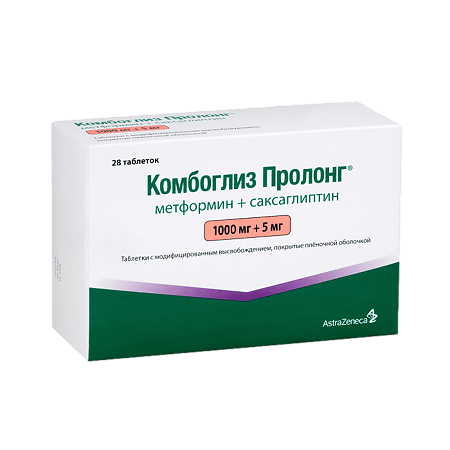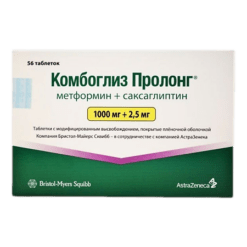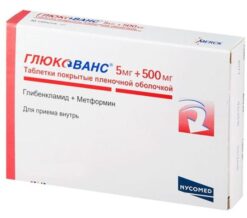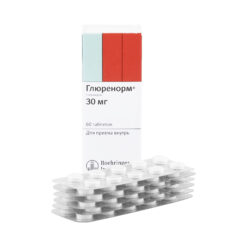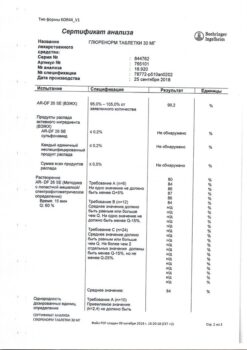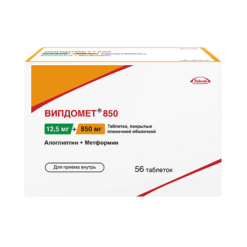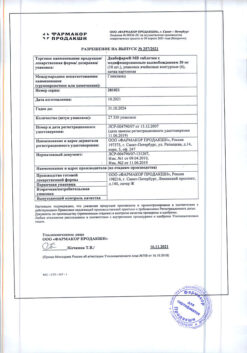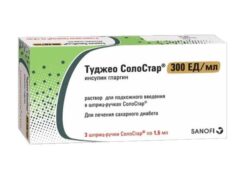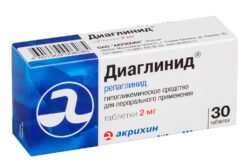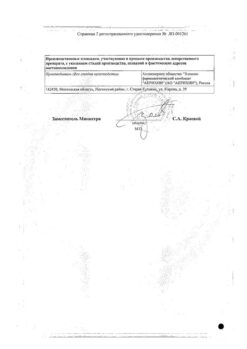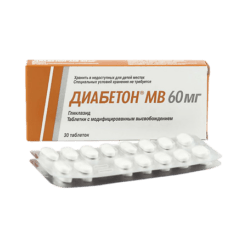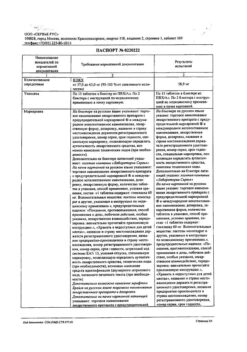No products in the cart.
Combogliz, 1000 mg+5 mg 28 pcs
€96.41 €80.34
Description
Combogliz Prolong® combines two hypoglycemic drugs with complementary mechanisms of action to improve glycemic control in patients with type 2 diabetes (T2DM): saxagliptin, a dipeptyl peptidase 4 (DPP-4) inhibitor, and metformin, a class of biguanides.
Saxagliptin:
In response to food intake, hormones such as glucagon-like peptide-1 (GFP-1) and glucose-dependent insulinotropic polypeptide (GIP) are released into the bloodstream from the small intestine. These hormones promote insulin release from pancreatic beta cells, which is dependent on blood glucose concentration, but are inactivated by DPP-4 enzyme within minutes. PPP-1 also decreases glucagon secretion in pancreatic alpha cells, reducing glucose production in the liver. In patients with DM2, the concentration of GFP-1 is reduced, but the insulin response to GFP-1 is maintained. Saxagliptin, as a competitive DPP-4 inhibitor, reduces inactivation of the hormone incretins, thereby increasing their concentrations in the bloodstream and leading to decreased glucose concentrations on an empty stomach and after meals.
Metformin:
Metformin is a hypoglycemic drug that improves glucose tolerance in patients with DM2 by lowering basal and postprandial glucose concentrations. Metformin reduces glucose production by the liver, reduces glucose absorption in the intestine and increases insulin sensitivity by increasing peripheral glucose uptake and utilization. Unlike sulfonylurea drugs, metformin does not cause hypoglycemia in patients with DM2 or healthy people (except in special situations, see sections “Caution” and “Special indications”), and hyperinsulinemia. During therapy with metformin, insulin secretion remains unchanged, although fasting insulin concentrations and in response to meals during the day may decrease.
Indications
Indications
Type 2 diabetes combined with diet and exercise to improve glycemic control.
Pharmacological effect
Pharmacological effect
Comboglise Prolong® combines two hypoglycemic drugs with complementary mechanisms of action to improve glycemic control in patients with type 2 diabetes mellitus (T2DM): saxagliptin, a dipeptyl peptidase 4 (DPP-4) inhibitor, and metformin, a member of the biguanide class.
Saxagliptin:
In response to food intake, incretins such as glucagon-like peptide-1 (GLP-1) and glucose-dependent insulinotropic polypeptide (GIP) are released into the bloodstream from the small intestine. These hormones promote the release of insulin from the beta cells of the pancreas, depending on the concentration of blood glucose, but are inactivated by the DPP-4 enzyme within a few minutes. GLP-1 also reduces glucagon secretion in the alpha cells of the pancreas, reducing glucose production in the liver. In patients with T2DM, GLP-1 concentrations are reduced, but the insulin response to GLP-1 is maintained. Saxagliptin, being a competitive inhibitor of DPP-4, reduces the inactivation of incretin hormones, thereby increasing their concentrations in the bloodstream and leading to a decrease in fasting and postprandial glucose concentrations.
Metformin:
Metformin is a hypoglycemic drug that improves glucose tolerance in patients with T2DM by lowering basal and postprandial glucose concentrations. Metformin reduces hepatic glucose production, reduces intestinal glucose absorption, and increases insulin sensitivity by increasing peripheral glucose uptake and utilization. Unlike sulfonylureas, metformin does not cause hypoglycemia in patients with type 2 diabetes or healthy people (except in special situations, see sections “Precautions” and “Special Instructions”), and hyperinsulinemia. During metformin therapy, insulin secretion remains unchanged, although fasting and fasting insulin concentrations may decrease during the day.
Special instructions
Special instructions
Lactic acidosis is a rare, serious metabolic complication that can develop as a result of the accumulation of metformin during therapy with Comboglise Prolong. When lactic acidosis develops as a result of taking metformin, its concentration in the blood plasma exceeds 5 mcg/ml.
In patients with diabetes mellitus, lactic acidosis is more likely to develop with severe renal failure, including due to congenital kidney disease and insufficient renal perfusion, especially when taking multiple drugs. Patients with heart failure, particularly those with unstable angina or acute heart failure and risk of hypoperfusion and hypoxemia, are at increased risk of developing lactic acidosis.
The risk of developing lactic acidosis increases in proportion to the degree of renal failure and the age of the patient. Renal function should be regularly monitored in patients taking metformin and the minimum effective dose of metformin should be prescribed. In elderly patients, monitoring of renal function is necessary.
Metformin should not be prescribed to patients aged 80 years or older if renal function is impaired (as measured by CC), as these patients are more prone to developing lactic acidosis. In addition, it is necessary to immediately discontinue metformin therapy if conditions accompanied by hypoxemia, dehydration or sepsis develop. Because liver failure may significantly limit the ability to eliminate lactate, metformin should not be prescribed to patients with clinical or laboratory evidence of liver disease.
Active ingredient
Active ingredient
Metformin, Saxagliptin
Composition
Composition
Active substances:
Contraindications
Contraindications
– increased individual sensitivity to any component of the drug;
– serious hypersensitivity reactions (anaphylaxis or angioedema) to DPP-4 inhibitors;
— diabetes mellitus type 1 (use not studied);
– use in combination with insulin (not studied);
– congenital galactose intolerance, lactase deficiency and glucose-galactose malabsorption;
— pregnancy, lactation;
– age under 18 years (safety and effectiveness have not been studied);
– impaired renal function (serum creatinine ≥1.5 mg/dl [men], ≥1.4 mg/dl [women] or reduced creatinine clearance), including those caused by acute cardiovascular failure (shock), acute myocardial infarction and septicemia;
– acute diseases in which there is a risk of developing renal dysfunction: dehydration (with vomiting, diarrhea), fever, severe infectious diseases, hypoxia conditions (shock, sepsis, kidney infections, bronchopulmonary diseases);
– acute or chronic metabolic acidosis, including diabetic ketoacidosis, with or without coma;
– clinically pronounced manifestations of acute and chronic diseases that can lead to the development of tissue hypoxia (respiratory failure, heart failure, acute myocardial infarction);
– serious surgical operations and injuries (when insulin therapy is indicated);
– liver dysfunction;
— chronic alcoholism and acute ethanol poisoning;
– lactic acidosis (including history);
– a period of at least 48 hours before and within 48 hours after radioisotope or x-ray studies with the introduction of iodine-containing contrast agents;
– following a hypocaloric diet (
With caution
In persons over 60 years of age who perform heavy physical work (increased risk of developing lactic acidosis) and patients with a history of pancreatitis (the relationship between taking the drug and an increased risk of developing pancreatitis has not been established).
Side Effects
Side Effects
Monotherapy and adjunctive combination therapy
Saxagliptin
Table 1 summarizes the adverse events observed in clinical trials (regardless of investigator assessment of causality) in ≥ 5% of patients receiving saxagliptin 5 mg.
Table 1. Adverse events
Number (%) of patients
Saxagliptin 5 mg (N=882)
Placebo (N=799)
Upper respiratory tract infections
68 (7.7)
61 (7.6)
Urinary tract infections
60 (6.8)
49 (6.1)
Headache
57 (6.5)
47 (5.9)
The 5 placebo-controlled studies included two monotherapy studies and one each combination therapy study with the addition of metformin, thiazolidinedione or glibenclamide. The table presents data from a 24-week study regardless of the use of an additional hypoglycemic drug.
In patients receiving saxagliptin 2.5 mg, headache (6.5%) was the only adverse event reported with a frequency of ≥ 5% and occurred more frequently than in the placebo group.
Adverse events reported in ≥ 2% of patients treated with saxagliptin 2.5 mg or saxagliptin 5 mg and occurring ≥ 1% more often than placebo included sinusitis (2.9% and 2.6% versus 1.6%, respectively), abdominal pain (2.4% and 1.7% versus 0.5%), gastroenteritis (1.9% and 2.3% versus 0.9%) and vomiting (2.2% and 2.3% versus 1.3%).
The incidence of fractures was 1.0 and 0.6 per 100 patient-years, respectively, with saxagliptin (pooled analysis of doses of 2.5 mg, 5 mg and 10 mg) and placebo. The incidence of fractures in patients taking saxagliptin did not increase over time. A causal relationship has not been established, and preclinical studies have not shown any adverse effects of saxagliptin on bone tissue.
During the clinical program, the development of thrombocytopenia was observed, consistent with the diagnosis of idiopathic thrombocytopenic purpura. The relationship between the development of this phenomenon and the use of saxagliptin is not known.
Adverse events associated with co-administration of saxagliptin and metformin in the treatment of patients with type 2 diabetes mellitus (T2DM) who have not previously received therapy
Saxagliptin
Table 2 summarizes the adverse events reported (regardless of investigator assessment of causation) in ≥ 5% of patients participating in an additional 24-week active-controlled study of saxagliptin and metformin in treatment-naïve patients.
Table 2. Adverse events
Number (%) of patients
Saxagliptin 5 mg + metformin* (N=320)
Metformin* (N=328)
Headache
24 (7.5)
17(5.2)
Nasopharyngitis
22 (6.9)
13 (4.0)
*The initial metformin dose of 500 mg/day was increased to a maximum dose of 2000 mg/day.
In patients receiving the combination of saxagliptin and metformin, either as an add-on drug or as initial combination therapy, diarrhea was the only gastrointestinal adverse event that occurred in ≥5% of patients in either group. The incidence of diarrhea was 9.9%, 5.8% and 11.2% in the saxagliptin 2.5 mg, saxagliptin 5 mg and placebo groups, respectively, in the saxagliptin plus metformin study; The incidence of diarrhea was 6.9% and 7.3% in the combination therapy group of saxagliptin 5 mg and metformin and the metformin monotherapy group in the initial combination therapy with metformin study.
Hypoglycemia
Saxagliptin
Information on hypoglycemia as an adverse event was collected from reports of hypoglycemia; no concomitant measurement of glucose concentration was required. The incidence of hypoglycemia with saxagliptin 2.5 mg, saxagliptin 5 mg and placebo (all as monotherapy) was 4%, 5.6% and 4.1%, respectively, and 7.8%, 5.8% and 5%, respectively, with the addition of metformin. The incidence of hypoglycemia was 3.4% in treatment-naïve patients receiving saxagliptin 5 mg in combination with metformin and 4% in patients receiving metformin alone.
Hypersensitivity reactions
Saxagliptin
In an analysis of five pooled studies, hypersensitivity-related adverse events (such as urticaria and facial swelling) were reported in 1.5%, 1.5%, and 0.4% of patients receiving saxagliptin 2.5 mg, saxagliptin 5 mg, and placebo, respectively. According to the researchers, none of these events in patients receiving saxagliptin required hospitalization or were life-threatening. In this pooled data analysis, one patient receiving saxagliptin was excluded from the study due to the development of generalized urticaria and facial edema.
Indicators of physiological functions
Saxagliptin
In patients receiving saxagliptin as monotherapy or in combination with metformin, no clinically significant changes in physiological function parameters were detected.
Monotherapy
Metformin
In placebo-controlled studies, the most common adverse events reported in >5% of patients treated with metformin modified release and occurring more frequently than in the placebo group were diarrhea and nausea/vomiting.
Post-marketing use
The following side effects have been reported during post-marketing use of saxagliptin: acute pancreatitis and hypersensitivity reactions, including anaphylaxis, angioedema, rash and urticaria. It is impossible to reliably estimate the incidence of these phenomena, since reports were received spontaneously from a population of unknown size (see sections “Contraindications” and “Special Instructions”).
Laboratory research
Absolute lymphocyte count
Saxagliptin
A dose-dependent mean decrease in the absolute lymphocyte count was observed with saxagliptin. In an analysis of pooled data from five 24-week, placebo-controlled studies, there was a mean reduction of approximately 100 and 120 cells/μL in absolute lymphocyte count from a baseline mean of 2200 cells/μL with saxagliptin 5 mg and 10 mg, respectively, compared with placebo. A similar effect was observed when taking saxagliptin at a dose of 5 mg in the original combination with metformin compared with metformin monotherapy. There were no differences between saxagliptin 2.5 mg and placebo treatments. The proportion of patients whose lymphocyte count was ≤ 750 cells/μL was 0.5%, 1.5%, 1.4%, and 0.4% in the saxagliptin 2.5 mg, 5 mg, 10 mg, and placebo treatment groups, respectively. Most patients did not relapse when saxagliptin was re-administered, although in some patients lymphocyte counts relapsed when saxagliptin was reintroduced, leading to discontinuation of saxagliptin. The decrease in the number of lymphocytes was not accompanied by clinical manifestations.
The reasons for the decrease in lymphocyte counts during saxagliptin therapy compared with placebo are unknown. If an unusual or prolonged infection develops, the lymphocyte count should be measured. The effect of saxagliptin on lymphocyte counts in patients with lymphocyte count abnormalities (eg, human immunodeficiency virus) is unknown.
Platelets
Saxagliptin
Saxagliptin did not have a clinically significant or consistent effect on platelet counts across six double-blind, controlled clinical safety and efficacy studies.
Vitamin B12 concentration
In controlled clinical trials of metformin lasting 29 weeks, approximately 7% of patients experienced a decrease in previously normal serum vitamin B12 concentrations to subnormal values without clinical manifestations. However, such a decrease is very rarely accompanied by the development of anemia and is quickly restored after discontinuation of metformin or additional intake of vitamin B12.
Interaction
Interaction
Metformin
Some drugs increase hyperglycemia (thiazide and other diuretics, glucocorticosteroids, phenothiazines, iodine-containing thyroid hormone preparations, estrogens, oral contraceptives, phenytoin, nicotinic acid, sympathomimetics, slow calcium channel blockers and isoniazid).
When prescribing or discontinuing such drugs in a patient taking Comboglise Prolong, the concentration of glucose in the blood should be carefully monitored. Metformin has low plasma protein binding and is therefore unlikely to interact with drugs that are highly protein bound, such as salicylates, sulfonamides, chloramphenicol and probenecid (unlike sulfonylureas, which are highly protein bound).
Inducers of CYP3A4/5 isoenzymes
Saxagliptin
Rifampin significantly reduces the exposure of saxagliptin without changing the AUC of its active metabolite, 5-hydroxy-saxagliptin. Rifampicin has no effect on DPP-4 inhibition in plasma during the 24-hour treatment interval.
Inhibitors of CYP3A4/5 isoenzymes
Saxagliptin
Diltiazem enhances the effect of saxagliptin when used together. Increased plasma concentrations of saxagliptin are expected with the use of amprenavir, aprepitant, erythromycin, fluconazole, fosamprenavir, grapefruit juice and verapamil; however, dose adjustments of saxagliptin are not recommended. Ketoconazole significantly increases plasma concentrations of saxagliptin. Similar significant increases in plasma concentrations of saxagliptin are expected with the use of other potent inhibitors of CYP3A4/5 enzymes (for example, atazanavir, clarithromycin, indinavir, itraconazole, nefazodone, nelfinavir, ritonavir, saquinavir and telithromycin). When used together with a strong inhibitor of CYP3A4/5 isoenzymes, the dose of saxagliptin should be reduced to 2.5 mg.
Cationic drugs
Metformin
Cationic drugs (eg, amiloride, digoxin, morphine, procainamide, quinidine, quinine, ranitidine, triamterone, trimethoprim, or vancomycin) that are eliminated by the kidneys by glomerular filtration could theoretically interact with metformin by competing for common renal tubular transport systems. In single-dose and repeated-dose drug interaction studies of metformin and cimetidine, an interaction between oral metformin and cimetidine was observed in healthy volunteers; At the same time, there was a 60% increase in the maximum concentration of metformin in plasma and whole blood and a 40% increase in the AUC of metformin in plasma and whole blood. In a single-dose study, no change in half-life was observed. Metformin does not affect the pharmacokinetic parameters of cimetidine. It is recommended to closely monitor patients and adjust the dose if necessary in patients taking cationic drugs that are excreted through the proximal renal tubular system.
Glibenclamide
Metformin
In a single-dose interaction study in patients with T2DM, coadministration of metformin and glibenclamide did not affect pharmacokinetic or pharmacodynamic parameters.
Furosemide
Metformin
A single-dose drug interaction study of metformin and furosemide conducted on healthy volunteers revealed their pharmacokinetic interaction. Furosemide increases Cmax of metformin in plasma and blood by 22% and AUC in blood by 15% without significantly changing the renal clearance of metformin. When co-administered with metformin, the Cmax and AUC of furosemide are reduced by 31% and 12%, respectively, and the half-life is reduced by 32% without a noticeable change in the renal clearance of furosemide. There is no data on the interaction of metformin and furosemide when used together for a long time.
Nifedipine
Metformin
In a single-dose drug interaction study of metformin and nifedipine in healthy volunteers, nifedipine increased metformin plasma Cmax by 20% and AUC by 9%, and increased renal excretion. Tmax and T1/2 did not change. Nifedipine increases the absorption of metformin. Metformin has virtually no effect on the pharmacokinetics of nifedipine.
Saxagliptin and metformin
Co-administration of single doses of saxagliptin (100 mg) and metformin (1000 mg) does not have a significant effect on the pharmacokinetics of saxagliptin or metformin in healthy volunteers.
No special pharmacokinetic drug interaction studies have been conducted with Comboglise Prolong, although such studies have been conducted with its individual components: saxagliptin and metformin.
Saxagliptin
Effect of other drugs on saxagliptin
Glibenclamide: Co-administration of a single dose of saxagliptin (10 mg) and glibenclamide (5 mg), a CYP2C9 substrate, increased the Cmax of saxagliptin by 8%, but the AUC of saxagliptin did not change.
Pioglitazone: Co-administration of saxagliptin once daily (10 mg) and pioglitazone (45 mg), a CYP2C8 (strong) and CYP3A4 (weak) substrate, does not affect the pharmacokinetics of saxagliptin.
Digoxin: Co-administration of once daily saxagliptin (10 mg) and digoxin (0.25 mg), a P-glycoprotein substrate, does not affect the pharmacokinetics of saxagliptin.
Simvastatin: Co-administration of once daily saxagliptin (10 mg) and simvastatin (40 mg), a CYP3A4/5 substrate, increased the Cmax of saxagliptin by 21%, but the AUC of saxagliptin did not change.
Diltiazem: Combined single use of saxagliptin (10 mg) and diltiazem (360 mg extended dosage form at steady state), a moderate inhibitor of CYP3A4/5 isoenzymes, increases Cmax of saxagliptin by 63% and AUC by 2.1 times. This is accompanied by a corresponding decrease in Cmax and AUC of the active metabolite by 44% and 36%, respectively.
Ketoconazole: Coadministration of a single dose of saxagliptin (100 mg) and ketoconazole (200 mg every 12 hours at steady state) increases the Cmax and AUC of saxagliptin by 2.4 and 3.7 times, respectively. This is accompanied by a corresponding decrease in Cmax and AUC of the active metabolite by 96% and 90%, respectively.
Rifampicin: Coadministration of a single dose of saxagliptin (5 mg) and rifampicin (600 mg once daily at steady state) decreased the Cmax and AUC of saxagliptin by 53% and 76%, respectively, with a corresponding increase in Cmax (39%), but without a significant change in the AUC of the active metabolite.
Omeprazole: Combined repeated use of saxagliptin at a dose of 10 mg once daily and omeprazole at a dose of 40 mg, a substrate of the CYP2C19 isoenzyme (strong) and the CYP3A4 isoenzyme (weak), an inhibitor of the CYP2C19 isoenzyme and an MRP-3 inducer, does not affect the pharmacokinetics of saxagliptin.
Aluminum hydroxide + magnesium hydroxide + simethicone: Concomitant use of single doses of saxagliptin (10 mg) and a suspension containing aluminum hydroxide (2400 mg), magnesium hydroxide (2400 mg) and simethicone (240 mg) reduces Cmax of saxagliptin by 26%, but the AUC of saxagliptin does not change.
Famotidine: Administration of single doses of saxagliptin (10 mg) 3 hours after a single dose of famotidine (40 mg), an inhibitor of hOCT-1, hOCT-2, and hOCT-3, increased saxagliptin Cmax by 14%, but saxagliptin AUC did not change.
Overdose
Overdose
Saxagliptin
With long-term use of the drug in doses up to 80 times higher than recommended, no symptoms of intoxication are described. In case of overdose, symptomatic therapy should be used. Saxagliptin and its main metabolite are eliminated from the body by hemodialysis (removal rate: 23% of the dose in 4 hours).
Metformin
Cases of metformin overdose have been reported, including taking more than 50 g. Hypoglycemia developed in approximately 10% of cases, but its causal relationship with metformin has not been established. In 32% of cases of metformin overdose, patients experienced lactic acidosis. Metformin is eliminated by dialysis, with clearance reaching 170 ml/min.
Storage conditions
Storage conditions
At a temperature not higher than 30°C.
Shelf life
Shelf life
3 years
Manufacturer
Manufacturer
Bristol-Myers Squibb Holdings Pharma, Ltd. Liabil, USA
Additional information
| Shelf life | 3 years |
|---|---|
| Conditions of storage | At a temperature not exceeding 30 ° C. |
| Manufacturer | Bristol-Myers Squibb, USA |
| Medication form | controlled release tablets |
| Brand | Bristol-Myers Squibb |
Other forms…
Related products
Buy Combogliz, 1000 mg+5 mg 28 pcs with delivery to USA, UK, Europe and over 120 other countries.

